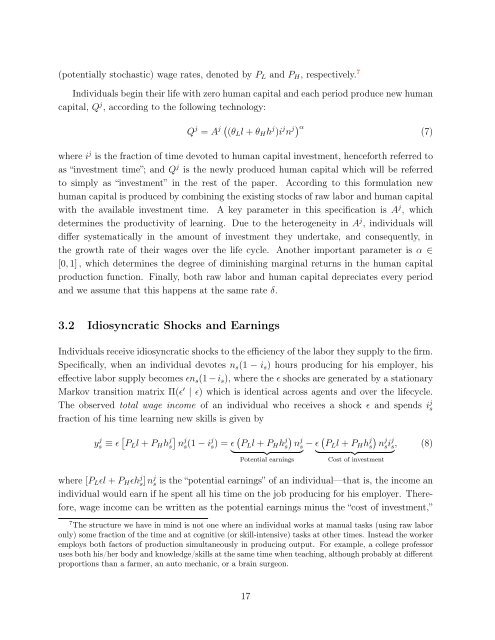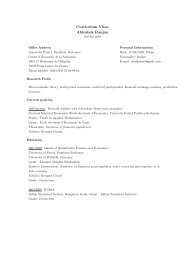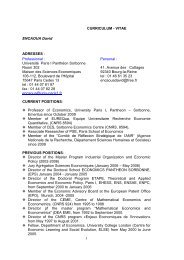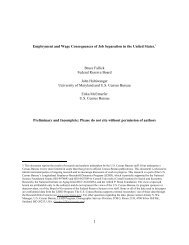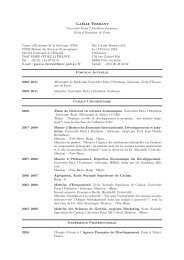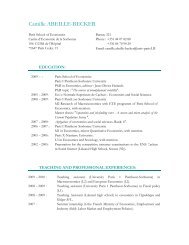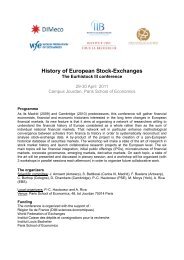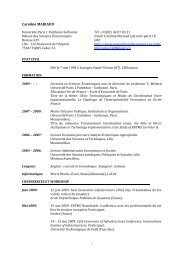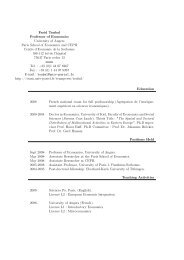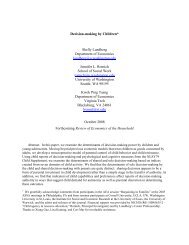info document - Paris School of Economics
info document - Paris School of Economics
info document - Paris School of Economics
You also want an ePaper? Increase the reach of your titles
YUMPU automatically turns print PDFs into web optimized ePapers that Google loves.
(potentially stochastic) wage rates, denoted by P L and P H , respectively. 7Individuals begin their life with zero human capital and each period produce new humancapital, Q j , according to the following technology:Q j = A j ( (θ L l + θ H h j )i j n j) α(7)where i j is the fraction <strong>of</strong> time devoted to human capital investment, henceforth referred toas “investment time”; and Q j is the newly produced human capital which will be referredto simply as “investment” in the rest <strong>of</strong> the paper. According to this formulation newhuman capital is produced by combining the existing stocks <strong>of</strong> raw labor and human capitalwith the available investment time. A key parameter in this specification is A j , whichdetermines the productivity <strong>of</strong> learning. Due to the heterogeneity in A j , individuals willdiffer systematically in the amount <strong>of</strong> investment they undertake, and consequently, inthe growth rate <strong>of</strong> their wages over the life cycle. Another important parameter is α ∈[0, 1] , which determines the degree <strong>of</strong> diminishing marginal returns in the human capitalproduction function. Finally, both raw labor and human capital depreciates every periodand we assume that this happens at the same rate δ.3.2 Idiosyncratic Shocks and EarningsIndividuals receive idiosyncratic shocks to the efficiency <strong>of</strong> the labor they supply to the firm.Specifically, when an individual devotes n s (1 − i s ) hours producing for his employer, hiseffective labor supply becomes ɛn s (1 − i s ), where the ɛ shocks are generated by a stationaryMarkov transition matrix Π(ɛ ′ | ɛ) which is identical across agents and over the lifecycle.The observed total wage income <strong>of</strong> an individual who receives a shock ɛ and spends i j sfraction <strong>of</strong> his time learning new skills is given byy j s ≡ ɛ [ P L l + P H h j s]njs (1 − i j s) = ɛ ( P L l + P H h j s)njs} {{ }Potential earnings− ɛ ( P L l + P H hs) j njs i j s} {{ } ,Cost <strong>of</strong> investment(8)where [P L ɛl + P H ɛh j s] n j s is the “potential earnings” <strong>of</strong> an individual—that is, the income anindividual would earn if he spent all his time on the job producing for his employer. Therefore,wage income can be written as the potential earnings minus the “cost <strong>of</strong> investment,”7 The structure we have in mind is not one where an individual works at manual tasks (using raw laboronly) some fraction <strong>of</strong> the time and at cognitive (or skill-intensive) tasks at other times. Instead the workeremploys both factors <strong>of</strong> production simultaneously in producing output. For example, a college pr<strong>of</strong>essoruses both his/her body and knowledge/skills at the same time when teaching, although probably at differentproportions than a farmer, an auto mechanic, or a brain surgeon.17


